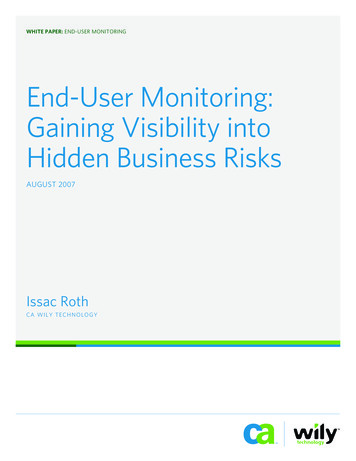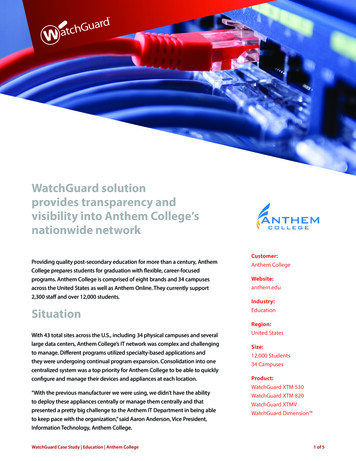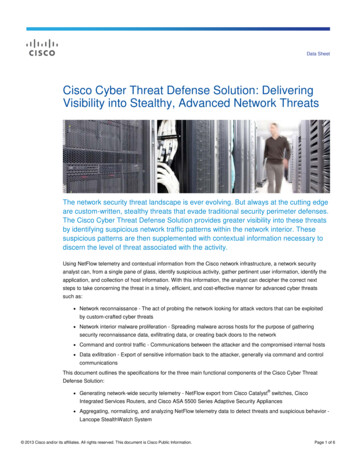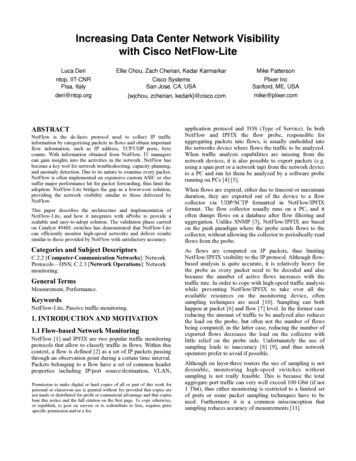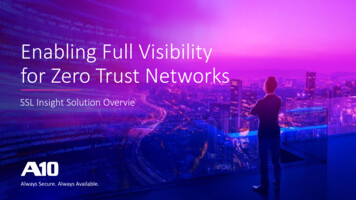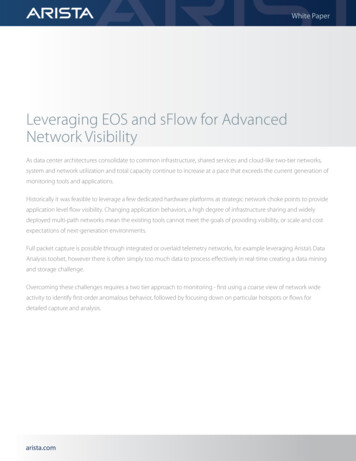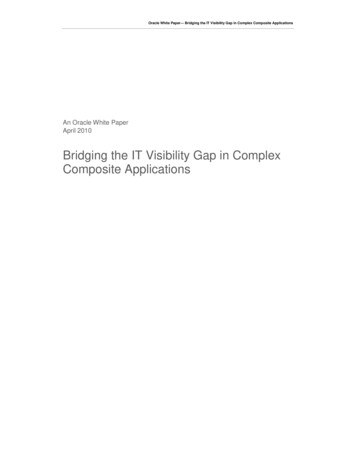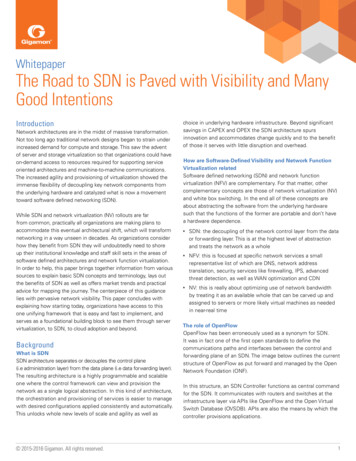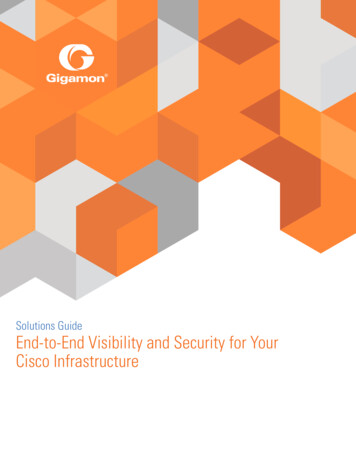
Transcription
Solutions GuideEnd-to-End Visibility and Security for YourCisco Infrastructure
Table of ContentsIntroduction 3Overview of Cisco Technologies 3Intelligent Packet Transformation to Enable ToolOptimization With GigaSMART 9De-duplication 93Header Stripping 9CISCO 40Gb BiDi Links 4SSL/TLS Decryption 9Cisco Fabric Extender (FEX) and VN-Tag 4Adaptive Packet Filtering 9Cisco FabricPath 4NetFlow and Metadata Generation 9Cisco Virtual Infrastructure 4Application Session Filtering 10Cisco Monitoring Methodologies 4Packet Slicing 10NetFlow/IPFIX 4Masking 10Cisco SPAN 5Source Port Labeling 10Cisco ERSPAN 5Tunneling 10Cisco RSPAN 6Advanced Tunneling including ERSPAN Termination 10Cisco VACL 6Time Stamping 10L7 Load Balancing 10Monitoring Cisco Application CentricInfrastructure (ACI) Inline Bypass Protection of Cisco FirePOWERIntrusion Prevention System (IPS) 6Requirements for End-to-End Visibility 7Gigamon Visibility Platform 7A New Approach to Monitoring 7Visibility Platform Benefits for Cisco ACI Implementations 8Benefits of Gigamon for Cisco Infrastructure 8Agile and Dynamic Patented Flow Mapping Technology 8 2014-2017 Gigamon. All rights reserved.Scalable Visibility into Cisco Virtual Infrastructure 10Inline Bypass Protection of Cisco FirePOWERIntrusion Prevention System (IPS) 11Achieving End-to-End Visibility 11End-to-End Security of Cisco NetworksUsing GigaSECURE 12Optimize Your Cisco Network withMetadata Generation 13Conclusion 13About Gigamon 132
Solutions Guide: End-to-End Visibility and Security for Your Cisco InfrastructureIntroductionOverview of Cisco TechnologiesAcross the globe, many companies choose a Cisco networkinginfrastructure to service their physical and virtual networking needsfor enterprise and data center operations. When implementinga large-scale Cisco network, monitoring tools typically rely uponCisco technologies, such as NetFlow, SPAN, RSPAN, ERSPAN, andVACL for traffic visibility. Traffic is extracted and sent to the tools.However, these technologies are often difficult to scale and canmodify traffic (e.g. encapsulate traffic), making it difficult to supportthe diverse monitoring needs of network, security, application, andserver groups as they strive to maintain maximized uptime, securethe network, realize operational efficiencies, and gain greaterinsight into business decision making.Cisco provides a wide range of solutions and technologies todeliver a network optimized for performance. Network, security,application, and server teams are accountable to ensure theinfrastructure is manageable, efficient, and secure. This sectionprovides an overview of Cisco technologies, monitoring methods,and challenges affecting end-to-end visibility:In addition, gaining end-to-end visibility across physical, virtual,and emerging architectures such as Cisco’s Application CentricInfrastructure (ACI) and Software Defined Networking (SDN)environments can be challenging, not only during the initialperiod of transition, but also after the rollout is completed.The interaction between multiple ACI components—APIC(Controller), Application Network Profiles and the underlying ACIfabric—means that the reliance on traffic to comprehensivelydetermine real-time state of the infrastructure only increases.Moreover, the use of integrated overlay technologies, such asVXLAN inside the ACI fabric, means that operational tools thatneed visibility inside the platform need a translation layer thatremoves the VXLAN headers and extracts traffic from a particularEndpoint Group before sending traffic to that operational tool.Additionally, ACI is often implemented as part of a 40Gb transitionand many customers choose Cisco 40Gb BiDi technology tosimplify the transition from 10Gb to 40Gb. During this transition,it is important to be mindful of maintaining visibility througha system of BiDi-capable network TAPs. ACI uses applicationnetwork profiles determined by application requirements toguide networking behavior and automate the provisioning of thenetwork. However, as emerging technologies like ACI evolve, sodoes the need to efficiently monitor and manage it.This guide reviews the various architecture and technologiesthat are typically deployed in Cisco networking infrastructureenvironments, identifies the key elements to building end-to-endvisibility that can help maximize effectiveness of the Ciscoinfrastructure, and illustrates how it can be achieved using theGigamon Visibility Platform. 2014-2017 Gigamon. All rights reserved. Application Centric Infrastructure (ACI) Cisco 40Gb BiDi Links Cisco Fabric Extender (FEX) and VN-Tag Cisco FabricPath Cisco Virtual Infrastructure Cisco Monitoring Methodologies–– NetFlow/IPFIX–– SPAN–– RSPAN–– ERSPAN–– VACL Inline Bypass Protection of Cisco FirePOWER IntrusionPrevention System (IPS)Monitoring Cisco Application Centric Infrastructure (ACI)Cisco’s innovative ACI architecture is designed to address the newworld of distributed applications in private cloud deploymentsand data centers. The ACI architecture uses two key concepts ofSDN—integrated overlays and a centralized controller to delivercentralized automation and policy-driven application networkprofiles. The Application Policy Infrastructure Controller (APIC)is the unification point of policy enforcement and translates theapplication-centric policies to network policy configuration thatare programmed into the underlying ACI fabric. Overlays providemore flexibility because they offer the power of separating devicelocation from device identity. For a network administrator, it isimportant to have the necessary visibility into the communicationbetween the APIC and the physical/virtual nodes to immediatelydetermine if the APIC and the infrastructure state are ever out ofsync. Further, being able to correlate network traffic activity towhat the controller expects the switches to be doing is going tobe a critical aspect of ensuring the success of SDN deployments.In addition, the use of technologies like VXLAN introduces newvisibility challenges. The wide range of operational tools used fornetwork administration is often unaware of VXLAN and requiresthe VXLAN headers to be stripped before they are delivered tothe tools. And, in a virtualized environment, the administratorneeds to have visibility into both virtual as well as physicalelements in the ACI fabric to ensure that there are no blind spotsin this infrastructure.3
Solutions Guide: End-to-End Visibility and Security for Your Cisco InfrastructureCisco 40Gb BiDi LinksOne of the design elements of ACI is the move to leaf/spineinfrastructures running over 40Gb links. Unfortunately, traditional40Gb short-range links require multiple lanes of multi-mode fiberthat requires using up to four such pairs of fiber. In many cases,fiber is deployed in groups of 12. Consequently, an upgrade from10Gb to 40Gb could create a 6x increase in fiber cost.the FabricPath headers that are added to the traffic in thisenvironment. In addition, even if the operational tool is able toremove such headers, additional CPU processing from the toolis required. Again, there is a need for a centralized monitoringinfrastructure with the ability to “normalize” traffic so that thevarious operational tools can gain visibility while maintainingefficiency to focus on their specialized tasks.To mitigate this issue, Cisco solves this challenge with aninnovation in 40Gb called BiDi that allows 40Gb traffic to run overexisting 10Gb cabling. This is done by multiplexing two lanes of20Gb on a single pair of multi-mode fiber. While this eliminatesthe fiber cost issue, it raises a new challenge that standard TAPscannot be used to monitor these links. Moreover, Cisco customerscan also implement 40Gb BiDi independent of ACI, which meansthat this challenge can be significantly more impactful.Cisco Virtual InfrastructureCisco Nexus 1000V Series represents the first example of thirdparty distributed virtual switches that are fully integrated withVMware virtual infrastructure, including VMware vCenter for thevirtualization administrator. When deployed, the Cisco Nexus1000V Series not only maintains the virtualization administrator’sregular workflow; it also offloads the vSwitch and port groupconfiguration to the network administrator, reducing networkconfiguration mistakes and helping ensure that consistentnetwork policy is enforced throughout the data center.Cisco Fabric Extender (FEX) and VN-TagWhen Cisco introduced the Unified Fabric, the goal was to unifystorage, data networking, and network services to deliver architecturalflexibility across physical, virtual, and cloud environments.One of the key components is the Cisco Fabric ExtenderTechnology (FEX), which delivers fabric extensibility across thenetwork and server hypervisor connectivity. The Cisco FEXTechnology includes a parent switch and an extender switch. Theparent switch can be a Cisco Nexus 5000 Series switch, Nexus6000 Series switch, Nexus 7000 Series switch, or a Cisco UCSFabric Interconnect. The fabric of the parent switch is extendedto connect to the server either as a remote line card with Nexus2000 Series Fabric Extenders or virtual adapter ports to connectto any type of servers—rack and/or blades, with Cisco AdapterFEX and VM-FEX technologies. Initially based on IEEE802.1Qbh,a VN-Tag is inserted into each frame exchanged between theextender switch and the Nexus parent switch.While the goal of Cisco’s Fabric Extender is to simplify datacenter connectivity, it introduces potential issues for the securityand analytic tools that do not fully understand VN-Tag headers orrequire additional CPU processing to remove the VN-Tag headers.Therefore, the need for a centralized monitoring infrastructurewith the ability to “normalize” traffic will help the tools regainvisibility, while maintaining operational efficiency.Cisco FabricPathWith Cisco FabricPath, highly scalable Layer 2 multipath networkscan be built simply and provisioned easily without SpanningTree Protocol. Such networks are particularly suitable for largevirtualization deployments, private clouds, and high-performancecomputing (HPC) environments. However, much like CiscoFabric Extender, Cisco FabricPath introduces potential blindspots for security and analytic tools that do not fully understand 2014-2017 Gigamon. All rights reserved.In the Cisco Nexus 1000V Series, traffic between virtual machineson the same host is switched locally without ever hitting thephysical switch or network, resulting in the increased potentialfor blind spots. Cisco technologies such as SPAN, RSPAN,ERSPAN, and VACL may be used on the Nexus 1000V, but thereare limitations that will be discussed in the next section of thisdocument—Cisco Monitoring Methodologies.Cisco Monitoring MethodologiesNetFlow/IPFIXThe combination of Cisco’s NetFlow and its standards-basedconstituent IPFIX is a feature that collects IP traffic statistics. Byanalyzing these statistics, known as NetFlow/IPFIX records, anetwork administrator can determine things such as the sourceand destination of the traffic, class of service, and the cause ofcongestion. This insight can help in optimizing resource usage,planning network capacity, and identifying the optimal applicationlayer for Quality of Service (QoS). It can also play a critical role innetwork security by detecting Denial of Service (DoS) attacks andnetwork-propagated worms.When enabled natively in the Cisco switching infrastructure,NetFlow could consume precious compute resources that mayburden the switch in times of high utilization potentially causingcontention for resources which could affect the performance ofthe network switching, the ability to deliver accurate NetFlowstatistics, or both. Often administrators correct for this by settinga low sampling rate. However, too low of a sample rate can resultin important network events being missed. In addition, NetFlowon an individual switch offers a limited view of traffic that theswitch sees. An out-of-band, centralized approach to NetFlowgeneration could offer visibility into NetFlow statistics acrossthe network and not affect the performance of the production4
Solutions Guide: End-to-End Visibility and Security for Your Cisco Infrastructurenetwork. The centralized approach is especially important inmodern data centers that are highly virtualized and featuredistributed applications. The ability to collect NetFlow recordsfrom a centralized point provides insight into the nature of trafficpatterns across the network vs. a single node. Often, the Ciscoinfrastructure is also used with other equipment that may notbe NetFlow capable; in this case, centralized NetFlow/IPFIXgeneration is a viable approach to gaining NetFlow visibility acrosssuch a multi-vendor network.Cisco SPANThe Switch Port Analyzer (SPAN) functionality is offered in allCisco switching solutions. A SPAN port copies data from oneor more source ports to a destination port. Figure 1 shows anexample of how the SPAN function operates. With most Ciscoswitching products, users are limited to two SPAN sessions perswitch. For large enterprises this is typically not adequate formonitoring purposes. In most large organizations between thenetwork and security groups there can be up to four or moremonitoring or analysis tools that all need to contend for thesame data. Examples of some of the tools that are utilized by ITteams are Application Performance Monitoring (APM), NetworkPerformance Monitoring (NPM), Intrusion Detection Systems(IDS), Data Recorders, Web monitoring tools, and many more.There are also other limitations with this model that preventusers from sending data from one source port to both of theavailable SPAN sessions, as well as limitations that allow VLANand non-VLAN traffic to be sent to the same port. In summary,SPAN sessions are good for spot analysis but are limited in termsof scaling to support enterprise-wide monitoring policies. SPANports are typically best for small to medium environments wheremonitoring needs are minimal.Source DataEgressTrafficSourceSPAN PortsIngressTrafficSourceSPAN PortsNetworkAnalysis ToolFigure 1: Cisco SPAN Example: Inside a Cisco switch data iscopied from a network port to a SPAN port which has amonitoring tool connectedCisco ERSPANEncapsulated Remote SPAN (ERSPAN) data from remoteswitches can be forwarded to a source monitoring tool over arouted network or Internet using a GRE Tunnel that is configuredon the Cisco switches (Figure 2).ERSPAN is a feature that is supported on Cisco switches beginningwith the Supervisor Engine 720 with PFC3A. This means the featurehas limited support beyond Cisco switch families such as theCatalyst 6500 and Nexus families. Packets of an ERSPAN session areencapsulated with a 50-byte header. Fragmented frames and jumboframes can be problematic. ERSPAN does not support fragmentedframes and all switches in the path have to be configured to supportjumbo frames otherwise frames that increase past the 1500-byteMTU limit with the 50 bytes of ERSPAN encapsulation are dropped.As with all other SPAN technologies, users can only create twoERSPAN destinations per switch. ERSPAN requires additionalconfiguration complexity to ensure that the tunneling and framesizes are correct for proper routing of data.SPAN Datain GRE TunnelSPAN Datain GRE TunnelSource DataSPAN Datain GRE TunnelMonitoring ToolFigure 2: Cisco ERSPAN example 2014-2017 Gigamon. All rights reserved.5
Solutions Guide: End-to-End Visibility and Security for Your Cisco InfrastructureCisco RSPANCisco Remote Switch Port Analyzer (RSPAN) works very much likeSPAN with the exception that data can be sent between remotemonitoring ports in the switching architecture using the CiscoVLAN Trunking Protocol (VTP) and reflector ports (Figure 3).Users are only allowed to send data to two RSPAN destinations.Similar to the SPAN function, data from the same source portor VLAN cannot be shared across the two sessions. RSPANpresents configuration complexity as users have to configure thecorrect VTP domains on each switch that RSPAN data traverses.In addition to the potential for duplicate packets in SPANconfiguration, an RSPAN will not pass Layer 2 data.Originating switchwith reflector portRSPANVLANRSPANVLANSPANDataMonitoring ToolFigure 3: Cisco RSPAN Example: Data on the originating switchis sent over a RSPAN VLAN created using VTP and Reflector PortsCisco VACLVLAN access lists (VACLs) overcome most SPAN limitations inaddition to providing the ability to filter for certain types of trafficsuch as a TCP port or IP address. VACLs are ACLs that apply to allpackets, whether bridged within a VLAN or routed to/from a VLAN(unlike ACLs that are typically configured on router interfaces andapplied on router ports). See Figure 5. The maximum numberof VACLs a switch can support is determined by the numberof VLANs in a switch. For example, if a switch only has fiveconfigured VLANs, then five VACL capture ports can be created.Users will mainly use VACLs to free up SPAN resources as a BandAid to a complete monitoring infrastructure. Configuring VACLs isusually reserved for more senior networking staff as VACLs requirethe most configuration attention of all the Cisco network visibilitytechnologies. Many users can mistakenly block data from the VACLcapture port if care is not taken when configuring the VACL. LikeSPANs, source data cannot be sent to multiple VACLs limiting thebenefit of having extra VACL ports as many times monitoring toolswill have to see many VLANs at once leaving the user with one ortwo VACL capture ports that can be used. 2014-2017 Gigamon. All rights reserved.VLAN 200Source Data PortACL RateACL RateACL RateACL RateVLAN 200, IP 1.1.1.1VACL PortMonitoring ToolFigure 4: Cisco VACL example: Data from IP address 1.1.1.1 inVLAN 200 is forwarded to a VLAN capture portInline bypass protection of Cisco FirePOWER IntrusionPrevention Systems (IPS)Given the attack continuum facing organizations before, duringand after an attack, organizations today need continuous securitymonitoring to cope with the new security landscape. In the worldof network security, visibility is everything. Limited access pointsto traffic in the infrastructure create blind spots. To cope with thisbroad range of challenges, organizations are keen on implementingeffective inline security systems for effective protection. Cisco’sFirePOWER IPS systems provide best-in-class protection to provideintelligent cybersecurity solutions. Implementing such solutionsinline need the following considerations: Ensure high availability and resiliency. When implementingFirePOWER IPS inline, security operations often face concernsraised by network operations on high availability and resiliency. Intelligent filtering of traffic to inline appliances. Securityoperations personnel also have a need to get real-time networktraffic of interest to avoid overloading the FirePOWER IPS Upgrade, add/remove new IPS without waiting for networkmaintenance windows. Security operations personnelneed to maintain, upgrade, add/remove the FirePOWER IPSappliances without having to coordinate maintenance windowswith network operations Application-aware filtering to decouple performance ofIPS from performance of the network: This allows 1GbFirePOWER appliances to be used in-line with a 10Gb networkand 10Gb appliances with a 40Gb network, increasing overallutilization without compromising security.6
Solutions Guide: End-to-End Visibility and Security for Your Cisco InfrastructureRequirements for End-to-End Visibilityprovide only relevant traffic information reducing the unnecessaryburden on the tools. In addition, features such as header strippingand decapsulation tunneling functions provide tools access toprotocols and data they may otherwise be blind to.The challenges around gaining end-to-end visibility across Ciscoinfrastructure and technologies are driving IT departments to look moreclosely at an out-of-band monitoring infrastructure to pr
Cisco Monitoring Methodologies – NetFlow/IPFIX – SPAN – RSPAN – ERSPAN – VACL Inline Bypass Protection of Cisco FirePOWER Intrusion Prevention System (IPS) Monitoring Cisco Application Centric Infrastructure (ACI) Cisco’s innovative
